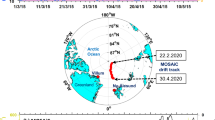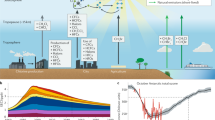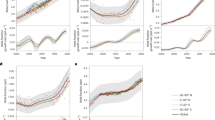Abstract
The possible impact of chlorine compounds on the Earth's ozone layer has caused concern. Profiles of the anthropogenic halocarbons F-11 (CFC13) and F-12 (CF2Cl2) have already been measured in the stratosphere1–4. Measurements of the vertical distribution of methyl chloride (CH3Cl), the most important natural chlorine-bearing species confirm that chlorine of anthropogenic origin now predominates the stratosphere5,6. More halogen radicals are added through decomposition of various other halocarbons, most of them released by man. We report here the first measurements of vertical profiles of F-13 (CF3Cl), F-14 (CF4), F-113 (C2F3Cl3), F-114 (C2F4Cl2), F-115 (C2F5Cl), F-116 (C2F6), and F-13 B(CF3Br) resulting from gas chromatography–mass spectrometer (GC–MS) analysis of air samples collected cryogenically between 10 and 33 km, at 44° N. Some data for F-22 (CHF2C1), methyl bromide (CH3Br) and methyl chloroform (CH3CC13) also presented are subject to confirmation.
This is a preview of subscription content, access via your institution
Access options
Subscribe to this journal
Receive 51 print issues and online access
$199.00 per year
only $3.90 per issue
Buy this article
- Purchase on Springer Link
- Instant access to full article PDF
Prices may be subject to local taxes which are calculated during checkout
Similar content being viewed by others
References
Fabian, P. et al. J. geophys. Res. 84, 3149 (1979).
Fabian, P. et al. J. geophys. Res. 86, 5179 (1981).
Goldan, P. W., Kuster, W. C., Albritton, D. L. & Schmeltekopf, A. L. J. geophys. Res. 85, 413 (1980).
Volz, A., Ehhalt, D. H. & Cosatto, H. Pure appl. Geophys. 116, 545 (1978).
Penkett, S. A., Derwent, R. G., Fabian, P., Borchers, R. & Schmidt, U. Nature 283, 58 (1980).
Schmidt, U. et al. Proc. Int. Ozone. Symp. Boulder 816 (1981).
Penkett, S. A., Presser, N. J. D., Rasmussen, R. A. & Khalil, M. A. K. J. geophys. Res. 86, 5172 (1981).
Rasmussen, R. A. & Khalil, M. A. K. Proc. NATO Adv. Study Inst. FAA-EE-80-20, 209 (1980).
Rasmussen, R. A., Rasmussen, L. E., Khalil, M. A. K. & Dalluge, R. W. J. geophys. Res. 85, 7350 (1980).
Singh, H. B., Salas, L. J., Shigeishi, H. & Scribner, E. Science 203, 899 (1979).
Goldman, A. et al. Geophys. Res. Lett. 6, 609 (1979).
Cicerone, R. J. Science 206, 59 (1979).
Rasmussen, R. A., Penkett, S. A. & Presser, N. J. D. Nature 277, 549 (1979).
Rasmussen, R. A., Khalil, M. A. K., Penkett, S. A. & Presser, N. J. D. Geophys. Res. Lett. 7, 809 (1980).
Author information
Authors and Affiliations
Rights and permissions
About this article
Cite this article
Fabian, P., Borchers, R., Penkett, S. et al. Halocarbons in the stratosphere. Nature 294, 733–735 (1981). https://doi.org/10.1038/294733a0
Received:
Accepted:
Issue Date:
DOI: https://doi.org/10.1038/294733a0
This article is cited by
-
Statistical and synoptical analysis of China’s carbon monoxide emission and transportation using satellite images
Modeling Earth Systems and Environment (2020)
-
Decrease in the growth rates of atmospheric chlorofluorocarbons 11 and 12
Nature (1993)
-
Ultraviolet absorption spectrum of trifluoro-bromo-methane, difluoro-dibromo-methane and difluoro-bromo-chloro-methane in the vapor phase
Journal of Atmospheric Chemistry (1989)
-
Measurements of atmospheric BrOx radicals in the tropical and mid-latitude atmosphere
Nature (1988)
-
Scenarios of possible changes in atmospheric temperatures and ozone concentrations due to man's activities, estimated with a one-dimensional coupled photochemical climate model
Climate Dynamics (1988)
Comments
By submitting a comment you agree to abide by our Terms and Community Guidelines. If you find something abusive or that does not comply with our terms or guidelines please flag it as inappropriate.



